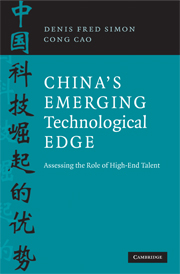Book contents
- Frontmatter
- Contents
- List of Figures and tables
- Acknowledgements
- Abbreviations
- Introduction
- 1 Human resources, technological innovation, and economic growth
- 2 China's talent challenge
- 3 Human resources in science and technology, and their structure and characteristics in China
- 4 Higher education and scientists and engineers in the pipeline
- 5 Utilization of scientists and engineers in China
- 6 “Brain drain,” “brain gain,” and “brain circulation”
- 7 Supply and demand of science and technology talent in China: key drivers
- 8 China's talent in key emerging technologies
- 9 Whither China's talent pool?
- Appendix: Understanding Chinese science and technology human resources statistics
- References
- Index
Introduction
Published online by Cambridge University Press: 25 January 2011
- Frontmatter
- Contents
- List of Figures and tables
- Acknowledgements
- Abbreviations
- Introduction
- 1 Human resources, technological innovation, and economic growth
- 2 China's talent challenge
- 3 Human resources in science and technology, and their structure and characteristics in China
- 4 Higher education and scientists and engineers in the pipeline
- 5 Utilization of scientists and engineers in China
- 6 “Brain drain,” “brain gain,” and “brain circulation”
- 7 Supply and demand of science and technology talent in China: key drivers
- 8 China's talent in key emerging technologies
- 9 Whither China's talent pool?
- Appendix: Understanding Chinese science and technology human resources statistics
- References
- Index
Summary
In the span of less than three decades, China has evolved from a peripheral player to become the most potent engine in the global economy. Along with its rapid economic progress, and the many improvements in the quality of life for large numbers of the Chinese population, a variety of indicators suggest that China's science and technology (S&T) capabilities also are on a sharply rising trajectory. Since the early 1990s, spending on S&T by the Chinese government has been increasing at a rate approximately twice that of overall economic growth. In 2007, China spent RMB (reminbi) 366 billion (US $50 billion) on research and development (R&D), or 1.49 percent of its increasing gross domestic product (GDP), highest among countries with similar economic development level, though the percentage is still lower than that of most of the major developed economies (NBS, 2008). Chinese institutions of higher education have been turning out an increasing number of well-prepared graduates. In 2006, China graduated some 159,000 students with masters and doctoral degrees in science and technology, on top of 1.34 million engineering undergraduates as well as 197,000 science undergraduates (NBS, 2007: 794). Unequivocally, this represents the world's highest output in terms of overall numbers.
In recent years, there also has been a steady increase in the number of international papers published by Chinese scientists.
- Type
- Chapter
- Information
- China's Emerging Technological EdgeAssessing the Role of High-End Talent, pp. xviii - xxviiiPublisher: Cambridge University PressPrint publication year: 2009
- 2
- Cited by



